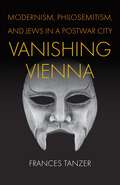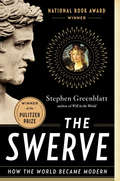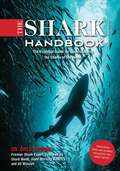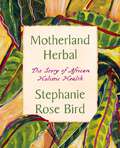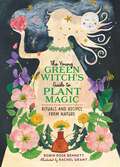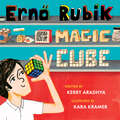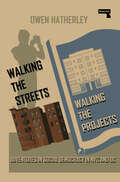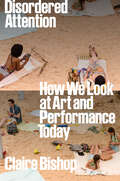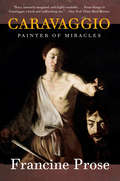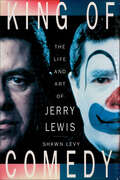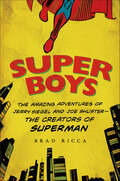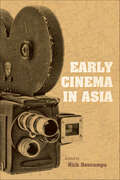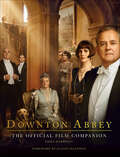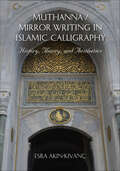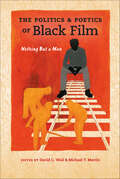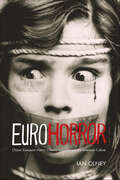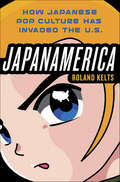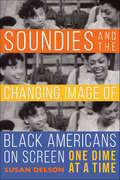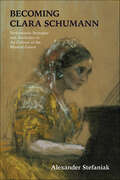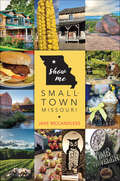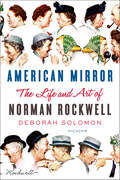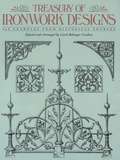- Table View
- List View
Vanishing Vienna: Modernism, Philosemitism, and Jews in a Postwar City (Jewish Culture and Contexts)
by Frances TanzerIn Vanishing Vienna historian Frances Tanzer traces the reconstruction of Viennese culture from the 1938 German annexation through the early 1960s. The book reveals continuity in Vienna’s cultural history across this period and a framework for interpreting Viennese culture that relies on antisemitism, philosemitism, and a related discourse of Jewish presence and absence. This observation demands a new chronology of cultural reconstruction that links the Nazi and postwar years, and a new geography that includes the history of refugees from Nazi Vienna.Rather than presenting the Nazi, exile, and postwar periods as discrete chapters of Vienna’s history, Tanzer argues that they are part of a continuous spectrum of cultural evolution—the result of which was the creation of a coherent Austrian identity and culture that emerged by the 1950s. As she shows, antisemitism and philosemitism were not contradictory forces in post-Nazi Austrian culture. They were deeply interconnected aspirations in a city where nostalgia for the past dominated cultural reconstruction efforts and supported seemingly contradictory impulses. Viennese nostalgia at times concealed the perpetuation of antisemitic fantasies of the city without Jews. At the same time, the postwar desire to return to a pre-Nazi past relied upon notions of Austrian culture that Austrian Jews perfected in exile, as well as on the symbolic remigration of a mostly imagined “Jewish” culture now taxed with redeeming Austria in the aftermath of the Holocaust. From this perspective, philosemitism is much more than a simple inversion of antisemitism—instead, Tanzer argues, philosemitism, problematic as it may be, defines Vienna in the era of postwar reconstruction.In this way, Vanishing Vienna uncovers a rarely discussed phenomenon of the aftermath of the Holocaust—a society that consumes, redefines, and bestows symbolic meaning on the victims in their absence.
The Swerve: How The World Became Modern
by Stephen GreenblattWinner of the Pulitzer Prize for Nonfiction • Winner of the National Book Award • New York Times Bestseller Renowned scholar Stephen Greenblatt brings the past to vivid life in what is at once a supreme work of scholarship, a literary page-turner, and a thrilling testament to the power of the written word. In the winter of 1417, a short, genial, cannily alert man in his late thirties plucked a very old manuscript off a dusty shelf in a remote monastery, saw with excitement what he had discovered, and ordered that it be copied. He was Poggio Bracciolini, the greatest book hunter of the Renaissance. His discovery, Lucretius’ ancient poem On the Nature of Things, had been almost entirely lost to history for more than a thousand years. It was a beautiful poem of the most dangerous ideas: that the universe functions without the aid of gods, that religious fear is damaging to human life, that pleasure and virtue are not opposites but intertwined, and that matter is made up of very small material particles in eternal motion, randomly colliding and swerving in new directions. Its return to circulation changed the course of history. The poem’s vision would shape the thought of Galileo and Freud, Darwin and Einstein, and—in the hands of Thomas Jefferson—leave its trace on the Declaration of Independence. From the gardens of the ancient philosophers to the dark chambers of monastic scriptoria during the Middle Ages to the cynical, competitive court of a corrupt and dangerous pope, Greenblatt brings Poggio’s search and discovery to life in a way that deepens our understanding of the world we live in now. “An intellectually invigorating, nonfiction version of a Dan Brown–like mystery-in-the-archives thriller.” —Boston Globe
The Shark Handbook: The Essential Guide for Understanding the Sharks of the World (Shark Week Author, Ocean Biology Books, Great White Shark, Aquatic History, Science and Nature Books, Gifts for Shark Fans)
by Greg SkomalDive deep into the world of sharks, the most fascinating and misunderstood marine animals on the planet, in this stunning new edition of The Shark Handbook, written by Shark Week expert, Dr. Greg Skomal.Did you know that a whale shark&’s spots are as unique as a fingerprint? Or that sharks can go into a trance when flipped upside down? Or that the Megallodon&’s mouth was 6 feet across? With The Shark Handbook, jump into brand new facts about these fierce sea creatures! Explore all of the orders of sharks, such as:Ground sharksGreat white sharksMackerel sharksCarpet sharksand more!Learn about over 400 profiles of every shark in existence, from the first sharks living about 445 million years ago to the ones lurking in the ocean deep today. Starring spectacular, full-color photography that makes these jaw-dropping sharks come to life, this is the perfect gift for the shark enthusiast in your life.Dr. Greg Skomal, PhD is an experienced aquarist and Marine Fisheries Biologist at Martha's Vineyard Fisheries, Division of Marine Fisheries, Massachusetts. He's been keeping saltwater aquariums since childhood and has shared his extensive knowledge with viewers of National Geographic, the Discovery Channel, NBC's Today, and other media.
Motherland Herbal: The Story of African Holistic Health
by Stephanie Rose BirdIn this powerful and comprehensive guide in the spirit of Jambalaya and Sacred Woman, an herbalist celebrates ancient and modern African holistic healing.“The message of this book is: hold onto your yams, your collards, watermelon, and roots. There is magic, mystery, connection, and healing stored within them.”—Stephanie Rose BirdStephanie Rose Bird grew up surrounded by forests, listening to the stories of her ancestors and learning African healing ways. From an early age, she dedicated herself to herbalism and living a spiritually fulfilled life in harmony with nature. Now, the wisdom she as accrued is gathered in this impressive encyclopedic work of African Healing and herbal medicine.Stephanie teaches you how to garden and harvest in unison with the seasons, and how to use herbalism and magic—derived from ancestral and spiritual helpers—to heal. A treasure trove of knowledge, Motherland Herbal showcases an array of recipes and rituals that nourish every facet of life:Seasonal recipes to support overall well-beingTinctures for common ailments such as headaches, flu, or heartburnRemedies for improving mental health, lessening symptoms of anxiety, stress, or depressionNatural body and home care products, from facials to cleaning solutionsHerbal Baths for relaxation, sexual wellness, and good luckRituals and Altars for universal experiences, such as learning to letting go after loss and improving creativity and fertilityLove Potions, Sleep Potions, Protective Amulets, and moreWritten in Stephanie’s warm and authoritative voice, Motherland Herbal seamlessly blends activism and ancestral folklore with the realms of spirituality, gardening, and holistic wellness. Her deep reverence for the wisdom of her ancestors infuses every page of this guide, which is a foundational resource that will shape the landscape of African healing and folk medicine for generations to come.Motherland Herbal includes 54 original pieces of art, including maps and artwork created by the author.
The Young Green Witch's Guide to Plant Magic: Rituals and Recipes from Nature
by Robin Rose BennettAn essential guide for any kid who wants to connect with natural magic, learn more about herbalism, and become more confident as they embrace their power with activities that support mindfulness and self-love. Green witches often start their journey by deciding to become best friends with one plant at a time. That plant becomes your ally. You come to know them, and in doing so, to know more about yourself. The plant will offer you teachings of physical, spiritual, mental, and emotional healing on the deepest levels to help you to grow, to feel safe in your body, and to become ever more joyful. In this book, readers will learn about nine plants that inspire wellness and self-care, as well as follow herbal recipes, start a green witch journal, practice magical rituals, and more. Whether you are making a body oil, a facial steam, or drinking a delicious tea in a moon ritual, the plants will awaken your magic and open you up to the joy and healing of the green world!
A Garland of Henna
by Varsha BajajNikita&’s family takes pride in creating beautiful henna art, and she&’s ready to try her hand at it—but it&’s harder than it looks!Nikita is part of a long line of henna artists. Her grandmother even brought a treasured notebook of designs with her to the US when she moved here from India. But the first time Nikita tries to make henna art, the mehndi paste looks like an ugly blob, and she feels like giving up. Still, she continues watching her mother and grandmother make gardens bloom on hands and is intrigued by the beauty of it all. Will she find the courage to try again? New York Times bestselling author Varsha Bajaj&’s poetic text and Archana Sreenivasan&’s dynamic illustrations perfectly capture Nikita&’s frustration, then pride, as she takes part in a beautiful family tradition.
Erno Rubik and His Magic Cube
by Kerry AradhyaThis first picture book biography of Rubik&’s Cube creator Erno Rubik reveals the obsession, imagination, and engineering process behind creating an iconic puzzle.Celebrating 50 years of the most popular puzzle in history!In the hills of Budapest, near the banks of the Danube River, lived a quiet boy named Ernő Rubik. He loved books, art, nature, and—most of all—puzzles. And he grew up to create the most popular puzzle in history. This picture book biography explores the experience and interests that inspired the inventor of the Rubik&’s Cube.From the time he was a child, Ernő was curious about the objects around him. What did they look like on the inside? What about geometric shapes? How many ways could he fit them together? Could he combine them so they somehow became something that was greater than its components?Ernő grew up and became a professor of architecture and design. Still fascinated with how shapes worked together, he fashioned an object, a cube made up of smaller cubes that twisted and turned without breaking. This object eventually became known as the most popular puzzle in history, the Rubik&’s Cube.Kerry Aradhya&’s accessible text takes us behind the scenes of the creative process and into the mind and imagination of a remarkable inventor. Kara Kramer&’s cheerful, multi-media illustrations encourage readers to think about inspiration, reflection, and the joy of puzzles—and solutions.
Walking the Streets/Walking the Projects: Adventures in Social Democracy in NYC and DC
by Owen HatherleyA walk through the remnants of a social democratic America, and an argument about its future.In the 1960s, a novel ideology about cities, and what was best for them, emerged in New York. Pushing against the state planning of the time, it held that cities were at their best when they were driven from the bottom-up and when organic, unplanned processes were allowed to run their course, in a spontaneous "ballet of the street". Cities were at their worst, however, when the state stepped in, demolishing lively old neighbourhoods and erecting giant, sterile, empty "projects". This book uses the method of this ideology — walking — to test how true it actually is about the "capital of the twentieth century", New York City, with a brief interlude in the capital, Washington DC.The "projects" that are walked in this book range from cultural complexes in Manhattan to New Deal-era public housing developments in Brooklyn, Harlem and Queens, from the social experiment of Roosevelt Island to Communist housing co-operatives in the Bronx, from the union-driven rebuilding of the Lower East Side to DC's magnificent Metro. For all their many flaws, they prove that Americans could, in fact, plan and build fragments of a better society, which survive and sometimes thrive today in one of the unequal places on earth. Walking the Streets/Walking the Projects takes a hard look at these enclaves, and asks what a new generation of American socialists might be able to learn from them.
Disordered Attention: How We Look at Art and Performance Today
by Claire BishopHow technology and the politics of attention changed the way we look at artThe ways we encounter contemporary art and performance has changed. How are we expectedto engage with today's diverse practice? Is the old model of close-looking still the ideal, or has itgiven way to browsing, skimming, and sampling?Across four provocative and insightful essays, art historian and critic Claire Bishop identifies trends in contemporary practice. Charting a critical path through the last three decades, Bishop pinpoints how spectatorship and visual literacy are evolving under the pressures of digital technology.She explores how researched-based exhibitions have proliferated turning the artist into an investigator or archivist with mixed results. Spatial performance can now involve the artist, dancers, or even the audience as participants, often framed with Instagram in mind. The political event is not longer activated without an understanding of the media that will record and distribute it. The proliferation of works that use modernist architecture is noticeable; but has this become a shorthand for something else?Disordered Attention is a vital survey of 21st century art, from one of the leading art thinkers ofour times.
Caravaggio: Painter of Miracles (Eminent Lives)
by Francine Prose“Matching gorgeous prose to gorgeous artworks, Prose responds to each image as a moment of theatrical revelation, sensual or spiritual, and frequently both.” — Boston Sunday GlobeIn Caravaggio, New York Times bestselling author Francine Prose offers an enthralling account of the life and work of one of the greatest painters of all time. Caravaggio defied the aesthetic conventions of his time; his use of ordinary people, realistically portrayed—street boys, prostitutes, the poor, the aged—was a profound and revolutionary innovation that left its mark on generations of artists. His insistence on painting from nature, on rendering the emotional truth of experience, whether religious or secular, made him an artist who speaks across the centuries to modern day. Called “racy, intensely imagined, and highly readable” by the New York Times Book Review, Caravaggio includes eight pages of color illustrations, and is sure to appeal to art enthusiasts interested in one of history’s true innovators. Caravaggio is part of the “Eminent Lives” series from HarperCollins, a selection of biographies by distinguished authors on canonical figures
King of Comedy: The Life and Art of Jerry Lewis
by Shawn LevyShawn Levy's fascinating biography King of Comedy - the product of vast research and interviews with contemporaries, admirers, foes, and even, briefly, Lewis himself - traces the story of a man who defines High American Show Biz. At points along the time line of his career, Lewis has been the highest-paid performer in history in film, on television, and (in 1995!) on Broadway. With partner Dean Martin, he was half of the most successful comedy duo of all time. He was the first director who debuted in talkies to direct himself. He was a direct, acknowledged influence on giants from Woody Allen to Lenny Bruce to David Letterman to Jim Carrey. He is a Chevalier of the French Legion of Honor, has raised over $1 billion in charity, and was once nominated for a Nobel Peace Prize. And, since the 1950s, he has been one of the most recognized faces on earth. For almost that long, though, people have argued over what Jerry Lewis means. Is he a talented comedian or a grotesque mimic? A startlingly original director or a pretender to Chaplin's throne? A multifaceted entertainer or a megalomaniacal egoist? A tireless champion of the disabled or a tireless self-promoter who has confused America's charitable impulses with affection for him as a performer?
Super Boys: The Amazing Adventures of Jerry Siegel and Joe Shuster—the Creators of Superman
by Brad RiccaIn time for the 75th anniversary of the Man of Steel, comes the first comprehensive literary biography of Joe Shuster and Jerry Siegel, creators of the DC Comics superhero Superman and the inspiration for Michael Chabon's Kavalier and ClayDrawing on ten years of research in the trenches of Cleveland libraries, boarded-up high schools, and secret, private collections, and a love of comic books, Brad Ricca's Super Boys is the first ever full biography about Superman's creators. Among scores of new discoveries, the book reveals the first stories and pictures ever published by the two, where the first Superman story really came from, the real inspiration for Lois Lane, the template for Superman's costume, and much, much more. Super Boys also tracks the boys' unknown, often mysterious lives after they left Superman, including Siegel's secret work during World War II and never-before-seen work from Shuster.Super Boys explains, finally, what exactly happened with the infamous check for $130 that pulled Superman away from his creators—and gave control of the character to the publisher. Ricca also uncovers the true nature of Jerry's father's death, a crime that has always remained a mystery. Super Boys is the story of a long friendship between boys who grew to be men and the standard that would be impossible for both of them to live up to.
Early Cinema in Asia
by Nick DeocampoEarly Cinema in Asia explores how cinema became a popular medium in the world's largest and most diverse continent. Beginning with the end of Asia's colonial period in the 19th century, contributors to this volume document the struggle by pioneering figures to introduce the medium of film to the vast continent, overcoming geographic, technological, and cultural difficulties. As an early form of globalization, film's arrival and phenomenal growth throughout various Asian countries penetrated not only colonial territories but also captivated collective states of imagination. With the coming of the 20th century, the medium that began as mere entertainment became a means for communicating many of the cultural identities of the region's ethnic nationalities, as they turned their favorite pastime into an expression of their cherished national cultures. Covering diverse locations, including China, India, Japan, Philippines, Malaysia, Thailand, Iran, and the countries of the Pacific Islands, contributors to this volume reveal the story of early cinema in Asia, helping us to understand the first seeds of a medium that has since grown deep roots in the region.
Extraordinary Dogs: Stories from Search and Rescue Dogs, Comfort Dogs, and Other Canine Heroes
by John Schlimm Liz StavrinidesA beautiful photo book showcasing more than 50 heroic dogs "in uniform" and their stories, from photographer Liz Stavrinides and author John Schlimm. Extraordinary Dogs portrays more than fifty working dogs, along with the police officers, firefighters, veterans, and other trained volunteer handlers who serve side-by-side with them. Their moving stories and beautiful photographs are an unprecedented glimpse at Comfort Dogs and Search and Rescue Dogs, along with bomb-detecting TSA dogs and canine ambassadors from across the United States.* The stories of the Lutheran Church Charities K-9 Comfort Dogs take readers behind the scenes of their headlining deployments—such as the Boston Marathon bombing, Superstorm Sandy, and the mass shooting at Marjory Stoneman Douglas High School.* Search and Rescue K-9 teams reveal what it’s really like to travel into the eye of natural disasters, accidents, crime scenes, and the worst terrorist strike in recorded history. * At Washington Dulles International Airport, readers meet several of the Department of Homeland Security’s TSA dogs whose sole job it is to keep the flying public safe from explosives and other dangers.Extraordinary Dogs is both a portrait of what love, hope, courage, and heroism look like in their purest forms and a tribute to the eternal and impactful bonds we forge with our furry friends.
Downton Abbey: The Official Film Companion
by Emma MarriottThe official tie-in book for Downton Abbey, the full-length feature film.Downton Abbey: The Official Film Companion is a stunning memento, bringing the world and the characters of our favorite fictional country house to life. Featuring spectacular photographs from the production, interviews with the cast and crew, and a look into the historical and geographical backdrop of the film, this official guide to the Downton Abbey film is made to be treasured and loved by fans across the globe.The film revolves around the King and Queen making an official visit to Downton in 1927, and not only sees the return of all the main cast from the final television series, but also introduces some great British actors to the world of Downton, as we meet the royal family and their retinue. The accompanying book is lavishly illustrated with stunning shots from both behind and in front of the camera, which capture some wonderful off-guard moments during filming, as well as the original costume illustrations.
Muthanna/Mirror Writing in Islamic Calligraphy: History, Theory, and Aesthetics
by Esra Akin-KivançMuthanna, also known as mirror writing, is a compelling style of Islamic calligraphy composed of a source text and its mirror image placed symmetrically on a horizontal or vertical axis. This style elaborates on various scripts such as Kufic, naskh, and muhaqqaq through compositional arrangements, including doubling, superimposing, and stacking. Muthanna is found in diverse media, ranging from architecture, textiles, and tiles to paper, metalwork, and woodwork. Yet despite its centuries-old history and popularity in countries from Iran to Spain, scholarship on the form has remained limited and flawed. Muthanna / Mirror Writing in Islamic Calligraphy provides a comprehensive study of the text and its forms, beginning with an explanation of the visual principles and techniques used in its creation. Author Esra Akin-Kivanc explores muthanna's relationship to similar forms of writing in Judaic and Christian contexts, as well as the specifically Islamic contexts within which symmetrically mirrored compositions reached full fruition, were assigned new meanings, and transformed into more complex visual forms. Throughout, Akin-Kivanc imaginatively plays on the implicit relationship between subject and object in muthanna by examining the point of view of the artist, the viewer, and the work of art. In doing so, this study elaborates on the vital links between outward form and inner meaning in Islamic calligraphy.
The Politics & Poetics of Black Film: Nothing But a Man (Studies in the Cinema of the Black Diaspora)
by Michael T. Martin David C. WallWritten and directed by two white men and performed by an all-black cast, Nothing But a Man (Michael Roemer, 1964) tells the story of a drifter turned family man who struggles with the pressures of small-town life and the limitations placed on him and his community in the Deep South, an area long fraught with racism. Though unmistakably about race and civil rights, the film makes no direct reference to the civil rights movement. Despite this intentional absence, contemporary audiences were acutely aware of the social context for the film's indictment of white prejudice in America. To help frame and situate the film in the context of black film studies, the book gathers primary and secondary resources, including the original screenplay, essays on the film, statements by the filmmakers, and interviews with Robert M. Young, the film's producer and cinematographer, and Khalil Gibran Muhammad, the Director of the Schomburg Center for Research in Black Culture.
Euro Horror: Classic European Horror Cinema in Contemporary American Culture (New Directions in National Cinemas)
by Ian OlneyBeginning in the 1950s, "Euro Horror" movies materialized in astonishing numbers from Italy, Spain, and France and popped up in the US at rural drive-ins and urban grindhouse theaters such as those that once dotted New York's Times Square. Gorier, sexier, and stranger than most American horror films of the time, they were embraced by hardcore fans and denounced by critics as the worst kind of cinematic trash. In this volume, Olney explores some of the most popular genres of Euro Horror cinema—including giallo films, named for the yellow covers of Italian pulp fiction, the S&M horror film, and cannibal and zombie films—and develops a theory that explains their renewed appeal to audiences today.
Japanamerica: How Japanese Pop Culture Has Invaded the U.S.
by Roland KeltsContemporary Japanese pop culture such as anime and manga (Japanese animation and comic books) is Asia's equivalent of the Harry Potter phenomenon--an overseas export that has taken America by storm. While Hollywood struggles to fill seats, Japanese anime releases are increasingly outpacing American movies in number and, more importantly, in the devotion they inspire in their fans. But just as Harry Potter is both "universal" and very English, anime is also deeply Japanese, making its popularity in the United States totally unexpected. Japanamerica is the first book that directly addresses the American experience with the Japanese pop phenomenon, covering everything from Hayao Miyazaki's epics, the burgeoning world of hentai, or violent pornographic anime, and Puffy Amiyumi, whose exploits are broadcast daily on the Cartoon Network, to literary novelist Haruki Murakami, and more. With insights from the artists, critics, readers and fans from both nations, this book is as literate as it is hip, highlighting the shared conflicts as American and Japanese pop cultures dramatically collide in the here and now.
Soundies and the Changing Image of Black Americans on Screen: One Dime at a Time
by Susan DelsonIn the 1940s, folks at bars and restaurants would gather around a Panoram movie machine to watch three-minute films called Soundies, precursors to today's music videos. This history was all but forgotten until the digital era brought Soundies to phones and computer screens—including a YouTube clip starring a 102-year-old Harlem dancer watching her younger self perform in Soundies. In Soundies and the Changing Image of Black Americans on Screen: One Dime at a Time, Susan Delson takes a deeper look at these fascinating films by focusing on the role of Black performers in this little-known genre. She highlights the women performers, like Dorothy Dandridge, who helped shape Soundies, while offering an intimate look at icons of the age, such as Duke Ellington and Nat King Cole. Using previously unknown archival materials—including letters, corporate memos, and courtroom testimony—to trace the precarious path of Soundies, Delson presents an incisive pop-culture snapshot of race relations during and just after World War II.Perfect for readers interested in film, American history, the World War II era, and Black entertainment history, Soundies and the Changing Image of Black Americans on Screen and its companion video website (susandelson.com) bring the important contributions of these Black artists into the spotlight once again.
Becoming Clara Schumann: Performance Strategies and Aesthetics in the Culture of the Musical Canon
by Alexander StefaniakWell before she married Robert Schumann, Clara Schumann was already an internationally renowned pianist, and she concertized extensively for several decades after her husband's death. Despite being tied professionally to Robert, Clara forged her own career and played an important role in forming what we now recognize as the culture of classical music.Becoming Clara Schumann guides readers through her entire career, including performance, composition, edits to her husband's music, and teaching. Alexander Stefaniak brings together the full run of Schumann's concert programs, detailed accounts of her performances and reception, and other previously unexplored primary source material to illuminate how she positioned herself within larger currents in concert life and musical aesthetics. He reveals that she was an accomplished strategist, having played roughly 1,300 concerts across western and central Europe over the course of her six-decade career, and she shaped the canonization of her husband's music. Extraordinary for her time, Schumann earned success and prestige by crafting her own playing style, selecting and composing her own concerts, and acting as her own manager.By highlighting Schumann's navigation of her musical culture's gendered boundaries, Becoming Clara Schumann details how she cultivated her public image in order to win over audiences and embody some of her field's most ambitious aspirations for musical performance.
Show Me Small-Town Missouri
by Jake McCandlessWhere was Mark Twain born? What city has claim to a president who was only president for a day? Who has the best paddling trips in the Ozarks? What about the World's Largest Gift Store? Find these answers and more in Show Me Small-Town Missouri. Award-winning author Jake McCandless, a lover of small towns and adventures, traveled the state in search of amazing local experiences to share this treasure trove of what you can find in often-overlooked towns across Missouri. Featured are 90 sparkling gems found in all four of the state's geographical regions—the Northern Prairie, the Southwest Osage Plain, the Ozarks, and the Bootheel Lowlands. The must-see attractions, activities, restaurants, sweet shops, specialty shops, and unique vacation spots are showcased in full-color images with an easy-to-follow index to help you plan your trip.From galleries to hiking trails, candy factories to wineries, lakeside attractions to the best fireworks displays, Show Me Small-Town Missouri has everything you need to know for a day, weekend, or week full of fun.
American Mirror: The Life and Art of Norman Rockwell
by Deborah SolomonA NEW YORK TIMES BOOK REVIEW NOTABLE BOOK OF THE YEAR A FINALIST FOR THE LOS ANGELES TIMES BOOK PRIZE IN BIOGRAPHY AND SHORTLISTED FOR THE PEN/JACQUELINE BOGRAD WELD AWARD FOR BIOGRAPHY"Welcome to Rockwell Land," writes Deborah Solomon in the introduction to this spirited and authoritative biography of the painter who provided twentieth-century America with a defining image of itself. As the star illustrator of The Saturday Evening Post for nearly half a century, Norman Rockwell mingled fact and fiction in paintings that reflected the we-the-people, communitarian ideals of American democracy. Freckled Boy Scouts and their mutts, sprightly grandmothers, a young man standing up to speak at a town hall meeting, a little black girl named Ruby Bridges walking into an all-white school—here was an America whose citizens seemed to believe in equality and gladness for all.Who was this man who served as our unofficial "artist in chief" and bolstered our country's national identity? Behind the folksy, pipe-smoking façade lay a surprisingly complex figure—a lonely painter who suffered from depression and was consumed by a sense of inadequacy. He wound up in treatment with the celebrated psychoanalyst Erik Erikson. In fact, Rockwell moved to Stockbridge, Massachusetts so that he and his wife could be near Austen Riggs, a leading psychiatric hospital. "What's interesting is how Rockwell's personal desire for inclusion and normalcy spoke to the national desire for inclusion and normalcy," writes Solomon. "His work mirrors his own temperament—his sense of humor, his fear of depths—and struck Americans as a truer version of themselves than the sallow, solemn, hard-bitten Puritans they knew from eighteenth-century portraits."Deborah Solomon, a biographer and art critic, draws on a wealth of unpublished letters and documents to explore the relationship between Rockwell's despairing personality and his genius for reflecting America's brightest hopes. "The thrill of his work," she writes, "is that he was able to use a commercial form [that of magazine illustration] to thrash out his private obsessions." In American Mirror, Solomon trains her perceptive eye not only on Rockwell and his art but on the development of visual journalism as it evolved from illustration in the 1920s to photography in the 1930s to television in the 1950s. She offers vivid cameos of the many famous Americans whom Rockwell counted as friends, including President Dwight Eisenhower, the folk artist Grandma Moses, the rock musician Al Kooper, and the generation of now-forgotten painters who ushered in the Golden Age of illustration, especially J. C. Leyendecker, the reclusive legend who created the Arrow Collar Man.Although derided by critics in his lifetime as a mere illustrator whose work could not compete with that of the Abstract Expressionists and other modern art movements, Rockwell has since attracted a passionate following in the art world. His faith in the power of storytelling puts his work in sync with the current art scene. American Mirror brilliantly explains why he deserves to be remembered as an American master of the first rank.
Treasury of Ironwork Designs: 469 Examples from Historical Sources (Dover Pictorial Archive)
by Carol Belanger GraftonThe history of Western decorative arts is filled with splendid examples of ornamental ironwork — elaborately wrought designs for gates and fences, finials and posts, banisters, window grilles, signs and marquees, cathedral screens, and a host of other architectural and decorative features. This practical archive brings together nearly 500 outstanding examples of the ironmaker's art. Meticulously rendered in fine black-and-white line art, the designs have been reprinted from rare European and American catalogs and periodicals of the nineteenth and early twentieth centuries, including L'Art Pour Tous, Art Journal, The Illustrated London News, Harper's Monthly, and others.The designs illustrated here date from the Middle Ages through the nineteenth century, encompassing the ornate figuration of the Renaissance, the exuberant innovations of Baroque and Rococo artists, and the sinuous designs of nineteenth-century ironworkers inspired by the Art Nouveau aesthetic. Artists, architects, designers, and craftspersons will find this volume an ideal sourcebook of beautiful designs — all royalty-free — from a great tradition in the decorative arts.
Illinois Across the Land
by Lee Mandrell DeeDee Niederhouse-MandrellWhether you find beauty in a remote forest or a sparkling nighttime cityscape, Illinois offers jaw-dropping scenery and opportunities for adventure with stunning landscapes, natural wonders, small town charms, and big city thrills. Join photographers Lee Mandrell and DeeDee Niederhouse-Mandrell on a visual journey across the Prairie state, as they travel from the beaches of Lake Michigan over rolling forested hills and picturesque farmland, through covered bridges, past historic barns and windmills, and up to the edge of the awe-inspiring rocky cliffs of the Garden of the Gods.Featuring more than 140 gorgeous photos, Illinois Across the Land inspires travelers to explore the state and discover historic landmarks at the Lincoln Log Cabin State Historical Site, rushing waterfalls in Starved Rock State Park, native wildlife in Crab Orchard Wildlife Refuge, breathtaking sunsets at Carlyle Lake, and so much more!
